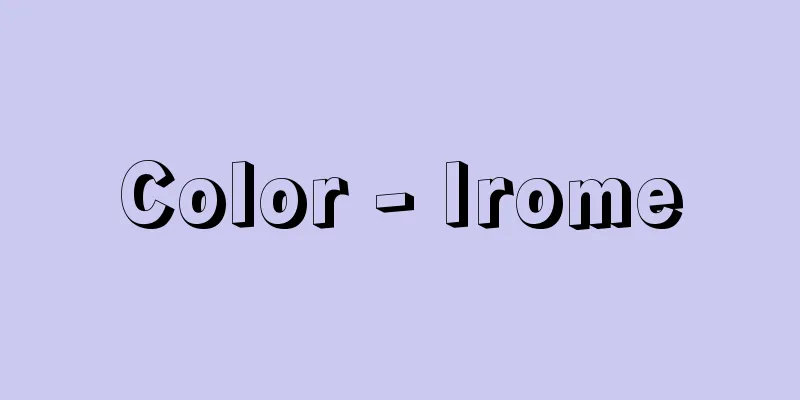Color - Irome

|
The name of the color scheme of clothing. It is often used to describe the color scheme of layered costumes worn by the aristocracy from the Heian period onwards. There are three types of colors in costumes: (1) woven colors, (2) front and back colors, and (3) overlapping colors. (1) is due to differences in the warp and weft threads of the fabric. When the warp and weft threads are woven with the same thickness and density, it becomes what is known as a "tamamushi" pattern, where the two colors appear to intertwine according to the height of the folds depending on the light. Also, if the thickness of the warp and weft threads is changed and one of them is raised to create a pattern, it becomes a two-color twill, where the colors of the ground and the pattern contrast with each other. A white weft twill, with a pattern created by placing white on the weft of a purple or indigo warp twill, is often seen on men's sashi-nuki. Also, several colors were added to the weft thread and woven into a floating weave, which was used for men's kariginu (hunting clothes), women's uwagi (outer garments), karaginu (traditional Chinese garments), and uchiki (undergarments). (2) The colors of the front and back of the garment are a combination of the two colors of the front and back of the garment, such as "sakura no naoshi" (cherry blossom nooshi), and are naturally visible in a lined garment. When considering the weaving and tailoring, the above two points are problems that arise not only in the Heian period but also in other costumes, and are not really worth discussing. The most effective way to make the most of the characteristics of the costumes and bring out their beauty was the color combination mentioned here (3), which is the color combination of the layered clothing worn under the outer garment, and it can be said that the beauty of the twelve-layered kimono, which is the representative of the costumes, was created in this way. The combination of color combinations seems to have included "nioi" (scent) which is composed of layers of light and dark colors, and those which showed the contrasting effect of different colors. The Benibai-uchiki uchiki is an uchiki that goes from a plum color to vermilion and is matched in shades of color, whereas the one "that alternates between the five colors of persimmon, cherry blossom, yamabuki, plum color, and light yellow. Those who wore three colors would wear fifteen of each, and those who wore more than eighteen or twenty" (Eiga Monogatari) is likely a combination of several different colors, including shades. From the Nara period to the Heian period, there was a big change in the naming of colors in dyeing and weaving. Namely, apart from the abstract five colors consisting of the three primary colors of red, blue, and yellow plus white and black, the names of dyes such as crimson, purple, gardenia, oak, indigo, and madder were often used, but as can be seen in the above-mentioned colors of kimono, there were a great number of color names taken from the colors of concrete natural plants such as red plum, cherry, Japanese yarrow, and gentian. This gradually led to a trend for colors themselves to be linked to the seasons, and it was considered preferable to use colors that were appropriate for the season. Eventually, a specific time for wearing each color was determined, and the color scheme of clothing for each season seems to have been decided accordingly. However, such strict rules were established at the end of the Heian period, or rather after the Kamakura period, when the clothing of the nobility had matured and become formalized, and it is not believed that all of what is considered to be oiirome today is the same as that of the Heian period. The colors of the front and back of clothing were originally separate from oiirome, but at some point they came to be considered the same. After the Muromachi period, the use of oiromokume gradually disappeared due to the simplification of oiromokume costumes and the rise of kosode clothing, which accompanied the decline of aristocratic culture, with only a few remnants remaining in a formal revival during the Edo period and in the ceremonial clothing of the Imperial Court after the Meiji period. However, in the case of layered clothing in traditional Japanese clothing, the color scheme of the top and bottom pieces of clothing, and the use of colors around the hems and collar, the tradition of such delicate feelings regarding colors can be said to continue to live on today. [Yamabe Tomoyuki] ©Shogakukan "> Color examples Source: Shogakukan Encyclopedia Nipponica About Encyclopedia Nipponica Information | Legend |
|
衣服の色づかい、配色の色名。とくに平安時代以降、貴族階級の間に行われた襲(かさね)装束における色づかいについていわれることが多い。 装束における色目には通常、(1)織り色目と(2)表裏の色目、それに(3)襲色目の3種がある。(1)は、織物の経糸(たていと)と緯糸(よこいと)の違いによるもので、これは経緯の糸の太さと密度を同じにして織った場合には、いわゆる「玉虫」になって、光線のぐあいでひだの高低にしたがって、2色が交錯して見える。また経緯の太さを変え、そのいずれかを浮かせて文様を織り出せば、いわゆる2色の綾(あや)になって地と文様の色が相対する。紫、縹(はなだ)などの経綾地に緯に白を配して文様を表した緯白(ぬきじろ)の綾などが、男性の指貫(さしぬき)などに多くみられる。また緯糸に数色の色を入れて、これを浮織に織ったものが、男性の狩衣(かりぎぬ)や女性の表着(うわぎ)や唐衣(からぎぬ)、袿(うちき)などに用いられた。(2)の表裏の色目は、たとえば男性の直衣(のうし)などでも「桜の直衣」などというように、衣服の表地と裏地の2色の配合によるもので、袷(あわせ)仕立ての場合当然現れる色目である。 以上の二つは、織物、仕立てを考えた場合、とくに平安時代の襲装束でなくてもいくらもおこる問題で、あえて異とするに足りない。襲装束の特長を生かし、その美しさを発揮することにもっとも効果のあったのが、ここにいう(3)の襲色目であり、これは表衣の下に重ねる襲の着装の配色で、とくに襲装束の代表ともいうべき十二単(じゅうにひとえ)の美しさなどは、これによってつくりあげられたものといっていい。襲色目の取り合わせには、色の濃淡で階層的に構成される「匂(にお)い」、と異なった色の対照的な効果をみせたものとがあったようである。 紅梅襲の袿といえば、紅梅色から朱色に戻る袿を濃淡に従ってそろえたもの、これに対して「柿(かき)、桜、山吹、紅梅、萌黄(もえぎ)の五色をとり交わしつつ云々(いい)。三色着たるは十五ずつ云々、多く着たるは十八、二十にてでありける」(栄花物語)というのは、濃淡を含めた異系統の数色による襲色目であろう。 奈良時代から平安時代に入ると、染織における色名の称呼に大きな変化がみられる。すなわち、赤、青、黄の三原色に白と黒を加えた抽象的な5色以外の色には、紅、紫、支子(くちなし)、橡(つるばみ)、藍(あい)、茜(あかね)といった染料の名称が多く用いられていたのが、上述の襲の色にもみるように、紅梅、桜、山吹、竜胆(りんどう)といった具体的な自然の植物の色そのものからとった色名が非常に多くなってくる。そしてこのことは、しだいに色そのものが季節と結び付く傾向を生じ、季節にあった色目を用いることが好ましいものとされ、ついにはすべての色目に対していちいち着用の時期が定められて、これに従って四季折々の衣服の配色がなされたようにみえる。しかしこうした堅苦しい規則のようなことは、貴族の服飾が爛熟(らんじゅく)を経て形式化した平安末か、むしろ鎌倉時代以後にできあがったもので、今日襲色目としてあげられているものも、これらがすべて平安時代と同じものであるとは考えられない。衣服の表と裏の色目なども、元来は襲色目とは別のものであったのが、いつしかこれと一つに考えられるようになった。 襲色目も、室町時代以後は公家(くげ)文化の衰退に伴う襲装束の簡略化、小袖(こそで)服飾の勃興(ぼっこう)によって、しだいに廃絶してしまい、わずかに江戸時代の形式的な再興や、明治以後の宮廷儀式服のなかにその残骸(ざんがい)をとどめている。しかし伝統的な日本の服装における重ね着の場合、上下の衣服の配色や、裾(すそ)や襟回しなどの色づかいには、現在でもこうした色目に対する細やかな感情の伝統が生き続けているといえるであろう。 [山辺知行] ©Shogakukan"> 色目の例 出典 小学館 日本大百科全書(ニッポニカ)日本大百科全書(ニッポニカ)について 情報 | 凡例 |
Recommend
The double suicide blade is the first day of the month of ice - Shinju Yaiba wa Koori no Tsukiichi
Joruri. Sewamono. Three volumes. Written by Chikam...
Shari'at Allah (English spelling)
…In the early 19th century, a Muslim social refor...
mélodrame (English spelling)
…The English word melodrama is a borrowing from t...
Omonoimi - Omonoimi
It was the title of a job for the priests who ser...
Tenma
A commercial and industrial district in the south...
Galleria Palatina
…The national art museum in Florence, Italy. Also...
Alawi [Mountains] - Alawi
… [Nature] The country is divided into a narrow w...
Viscount
… [Europe] The nobility of ancient Rome did not h...
Rhodeus sericeus (English spelling) Rhodeussericeus
... The bitterlings of the Acheilognathinae famil...
doctor universalis
…His French name was Alain de Lille. He was born ...
Hensho - Hensho
A monk and poet of the early Heian period. Also w...
Inflammatory cyst - Inflammatory cyst
...It may appear slightly bluish, and when presse...
Pisonia alba (English spelling)
…[Kazuo Furusato]. … *Some of the terminology tha...
Kinda Kingdom - Kinda Kingdom (English spelling)
A kingdom in central Arabia in the 5th and 6th cen...
Confederate States of America - Confederate States of America
A confederation formed in 1861 by seven southern s...





![Tomiura [town] - Tomiura](/upload/images/67cc5ae39c218.webp)



